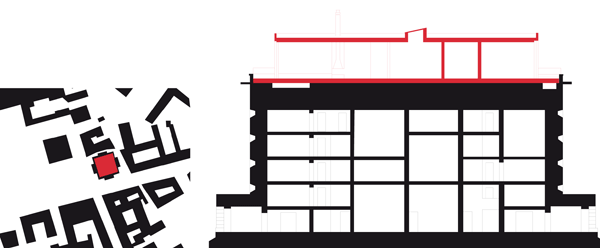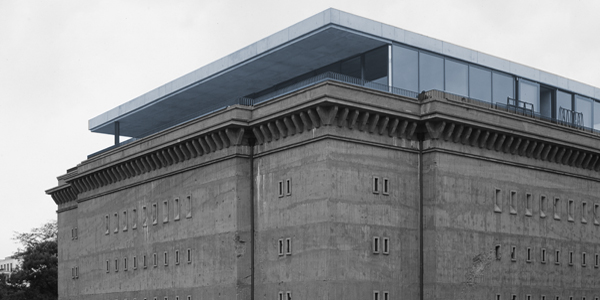
From Air-Raid to Art Shelter – Militärisches Bollwerk als Kunstbunker und Sockel für ein Penthouse
Der Luftschutzbunker wurde 1942 auf einem Block Eckgrundstück in Berlin-Mitte errichtet. Auf fünf gleichartigen Geschossen sind etwa 80 Räume angeordnet, die wegen ihrer neutralen Form gut für die Aufnahme der zeitgenössischen Kunstsammlung des Bauherrn geeignet sind.
Die geringen Geschosshöhen machten kleinteilige Umbauten notwendig. Mit Diamantsägen wurden gezielt einzelne Deckenteile und Wände herausgeschnitten. Die so entstandenen Räume verbinden die Geschosse nun über die gesamte innere Höhe miteinander. Außen wurden nachträgliche Anbauten entfernt, die Fassade gesäubert und, wo nötig, instand gesetzt sowie der ehemals umlaufende Sockel wiederhergestellt.
Um die auf dem Gebäudedach neu errichtete Flachdach-Wohnung zu erschließen, wurden zusätzlich 150 Kubikmeter Stahlbeton aus der drei Meter starken obersten Decke herausgeschnitten. Durch diese Öffnung wird der Wohnraum über eine Treppe aus Streckmetall und einen Aufzug zugänglich. Das Stahlbeton-Dach wiederholt die Grundrissform des Bunkers und lastet nahezu stützenfrei auf den Innenwänden.
Die umlaufende, selbsttragende Glasfassade gibt im Kontrast zu den massiven Bunkerwänden den Blick über die umliegende Stadtlandschaft frei. An der Süd- und Westseite springt die Glasfassade weit hinter die Dachkante zurück. An der Dachkante verlaufende, verschiebbare Elemente aus bronzenen Gittern schützen die unter dem Dach liegenden Außenräume wie die Terrassen, den Pool und den bepflanzten Dachgarten vor Blicken aus der Nachbarschaft.
Dadurch ist die dräuende Masse eines militärischen Bollwerks als Kunstbunker und Sockel eines Penthauses zu neuem Leben erwacht.
From Air-Raid to Art Shelter – A military bastion as art bunker and pedestal for a penthouse
This concrete air-raid bunker was built in 1942 on the corner of a city block in the Mitte district of Berlin. Five repetitive storeys contain 80 rooms whose neutrality forms a suitable showcase for the client's contemporary art collection.
The low ceiling heights made modifications necessary. Selected ceilings and walls were cut out with a diamondtoothed saw and removed. The resulting overlapping spaces now join the floors vertically throughout. Post-war additions were removed, the four façades were cleaned, renovated where required, and the plinth was restored.
To connect up to the newly created dwelling on top of the building, around 150 cubic metres of reinforced concrete were cut out of the bunker's three metre thick roof. The apartment is reached through this opening by way of a staircase of meshed steel and an internal open lift, which is partly clad in the same material.
The living spaces in the apartment are characterised by simple reinforced concrete walls, oak woodwork, floors of lacustrine limestone and the reinforced concrete roof, square in form like the Bunker below. The roof is supported almost entirely without columns, resting on the walls and the self supporting glass façade which, in contrast to the thick walls of the bunker, allows views across the surrounding cityscape. On the south and west, the line of the glass is set back from the edge of the roof. Movable bronze mesh screens along the perimeter of the roof give privacy to the outdoor living spaces, the roof garden with its terraces and flowerbeds, and the pool.
Thus the forbidding mass of a military bastion finds a new life as an art bunker and a pedestal for a penthouse.



